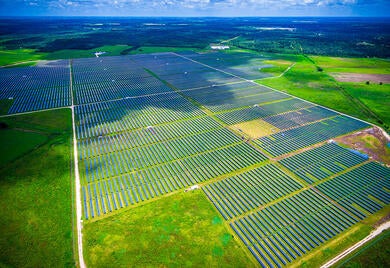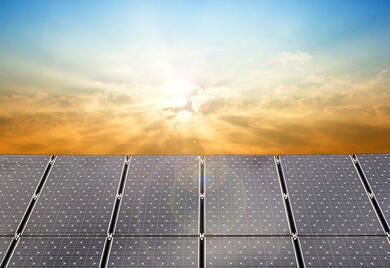
Four countries leading in solar in Latin America and the Caribbean
Nearly half of the global electric power capacity could come from solar energy by 2025, according to McKinsey & Company. Multiple Latin American and Caribbean countries, benefitting from exceptional resources and evolved regulatory frameworks, have seen rapid growth in solar energy in the last few years. Utility scale projects are now considered commercially viable and receive private financing, while the application of distributed solar is growing quickly. However, falling solar prices are squeezing the industry, and macroeconomic uncertainty will continue to test its strength. Meanwhile, developers are now consolidating to gain market share and achieve profitability.

Four reasons why the Caribbean private sector must invest in renewables
In the Caribbean, the year-round sunshine and extremely favorable insolation levels have not been enough to spur significant investments in renewable energy. Now, a year after the signature of the Paris Agreement, investments in solar energy seem more appealing than ever before, mainly due to four reasons:

The issues that marked the private sector in 2017
For the private sector, 2017 was a year marked by major changes and a call to prepare for the future. From the damages done by natural phenomena to the adoption of new technologies, several factors made this the year of adaptation, for both businesses and people. In this context, many Latin American and Caribbean countries began to explore new ways to grow, invest and even generate energy. Here we share the most discussed issues in 2017: 1. Solar energy took off In 2017, the constant increase in oil prices and the reduced cost of photovoltaic panels helped to spur notable growth in solar power, both in the developed markets and in Latin America and the Caribbean. The growth of this industry has gone hand in hand with the public and private sectors in the region, which have worked on procurement policies and programs to incentivize the use of clean energies, to transform the energy matrix and stimulate private investment. Review once again which countries are leading in solar energy in the region. 2. Natural disasters demand sustainable buildings Hurricanes and floods produced millions in losses, in Latin America and the Caribbean and the rest of the world during 2017. Hurricane Irma devastated the Caribbean, while other phenomena also left their mark in various countries of the region. For all of them, the lesson was clear: sustainable buildings are required. In all sectors, climate change is expected to continue causing havoc, and for this reason infrastructure must be increasingly more resilient. After the storm, many have already made the decision to adapt. We leave you with the case of Peru and its model of Reconstruction with Changes following the floods that swept through the north of the country. 3. Bitcoin whets investors’ appetite Bitcoin was another main issue in 2017. The cryptocurrency achieved fame when it entered the market, with prices above US$17,000, awakening crowds’ appetite. Although there are still many experts who warn about the risks of investing in digital currency, the imminent bubble it can cause in the markets, and the lack of regulation, it quickly became widespread. For many, investing in Bitcoin is a new way to diversify funds and even offset inflation in their countries. Also for this reason, every day there are more who seek to dabble in digital mining. Here we share the opportunities and dangers of Bitcoin mining in our region. 2017 was a year for adapting to new forms of construction, new ways to generate energy and even new ways to save and invest. For companies in Latin America and the Caribbean, this capacity will be key to continuing to have an impact on development and growing sustainably. As Peter Druker says: “the entrepreneur always searches for change, responds to it and exploits it as an opportunity.” What changes do you think will occur in 2018? Discover the rest of most searched terms during the year in Google Year in Search 2017.

How to calculate the cost of generating electricity
When I attend energy conferences in Latin America and the Caribbean, whether as a panelist or attendee, I often hear questions such as: What type of energy is cheaper: thermoelectric or renewable energy? And what is the most competitive renewable technology: hydroelectric, solar, or wind? These are also the basic questions that regulatory entities ask when planning to expand their energy matrices. Investors also ask these questions when seeking opportunities for investment in the region. Comparing apples and oranges The answer is not so simple. We are talking about different technologies with different investment requirements, dissimilar service life, capacity factors and operational costs that vary based on the project type and location. The levelized cost of energy (LCOE) is a useful tool that can be used to consistently compare the costs of different types of technologies (solar, wind, natural gas, etc.). How to calculate the levelized cost of energy (LCOE) In simple terms, the LCOE consists of calculating the total average cost of building and operating an electrical power station and dividing it among the total energy to be generated over its entire service life. The National Renewable Energy Laboratory (NREL) has financial models available to the public that can be used to calculate the LCOE for solar and wind plants. The models contain variables such as the investment cost necessary to build the plant, the useful life of the power station, and annual operating and maintenance costs, among other variables. Performing a sensitivity analysis of these different variables allows us to determine which specific actions can be taken to reduce the levelized cost of electricity in a specific project. The conclusions may vary, from changing the equipment provider to reconsidering the project’s site. What information can be obtained from the LCOE? The first benefit is the ability to compare to make informed decisions. The LCOE tool also: Provides a break-even point: Its result, expressed in kilowatt hours (kWh), can also be considered the break-even point for an electrical power station, i.e. the minimum price at which it would have to sell electricity to neither gain nor lose. Yields interesting conclusions: Using the LCOE as a tool for a competitive measure among various sources of energy allows for obtaining diametrically different results, even within the same technology. For example, the LCOE in a country with ideal geography for mini-hydroelectric power stations (in terms of both investment cost and plant factors) could be much less than a run-of-river hydroelectric power station in a flat country with high labor costs. Measures competitiveness trends among different technologies over time. Thus, five years ago the levelized cost of solar plants could not compete with other sources of energy. Thanks to the drastic reduction in investment cost, solar plants now compete at the same level as other technologies in bidding for energy contracts. LCOE and other available tools IRENA, in its 2016 publication, analyzes levelized cost of renewable energy trends in Latin America and the Caribbean with revealing conclusions. Even though the cost of installing wind farms in the region is slightly higher than in more developed countries (such as India and China), the region’s higher level of wind resources makes it possible to achieve a higher capacity factor —the ratio between the actual energy generated during a given period and what would have been produced if the plant had been continuously operating at nominal power during that period— resulting in a comparatively similar LCOE. For example, in some areas of Brazil, the plant factor reached 50 percent. It should be emphasized that although the LCOE is widely used to compare unit costs among technologies, the methodology does have some limitations since its results are highly dependent on the scope and assumptions used. Nonetheless, there are various tools and technologies that seek to determine relative economic competitiveness among different technologies. These include the Levelized Avoided Cost of Energy (LACE), which measures the avoided cost of electricity of a new electrical power plant due to the displacement that the new infrastructure produces in the system. However, this will be the subject of a future blog entry. Subscribe to receive more content like this! [mc4wp_form]